Kaplan Professional Financial Planning Fundamentals DFP1v1 Assignment
VerifiedAdded on 2020/09/08
|42
|11920
|212
Homework Assignment
AI Summary
This document presents a comprehensive solution to a Financial Planning Fundamentals assignment (DFP1v1) for Kaplan Professional. The assignment focuses on a case study involving Steve and Crystal Riley, a young couple seeking financial advice. The solution includes a detailed fact find, analysis of their financial situation, and responses to various questions related to their financial goals, liabilities, assets, income, and expenditure. The assignment covers key financial planning concepts such as budgeting, debt management, superannuation, and investment strategies, providing a practical application of financial planning principles. The document demonstrates the application of financial planning knowledge and skills to address the client's needs and provide appropriate recommendations. The assignment also involves the application of relevant tax rates and other financial regulations.
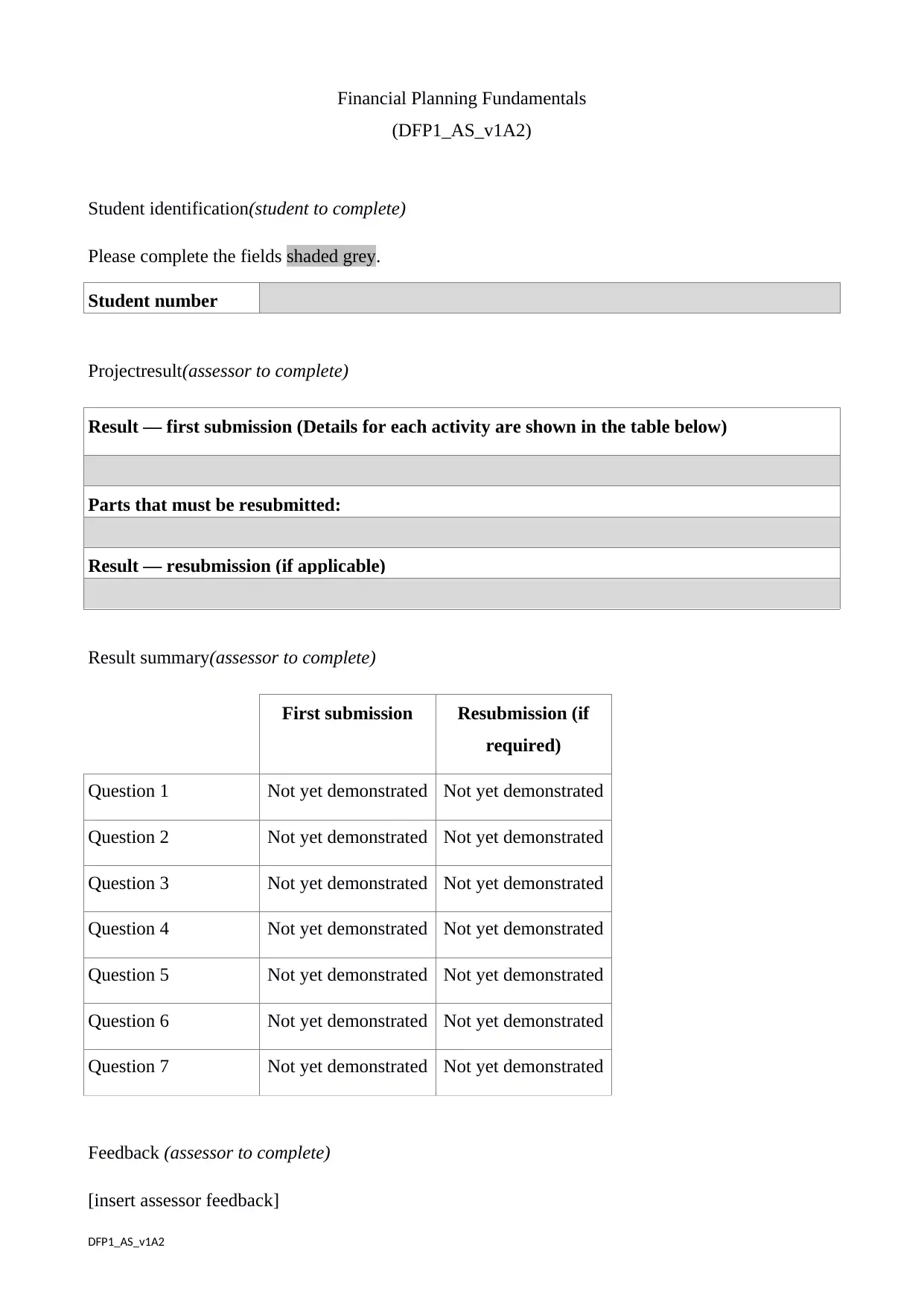
Financial Planning Fundamentals
(DFP1_AS_v1A2)
Student identification(student to complete)
Please complete the fields shaded grey.
Student number
Projectresult(assessor to complete)
Result — first submission (Details for each activity are shown in the table below)
Parts that must be resubmitted:
Result — resubmission (if applicable)
Result summary(assessor to complete)
First submission Resubmission (if
required)
Question 1 Not yet demonstrated Not yet demonstrated
Question 2 Not yet demonstrated Not yet demonstrated
Question 3 Not yet demonstrated Not yet demonstrated
Question 4 Not yet demonstrated Not yet demonstrated
Question 5 Not yet demonstrated Not yet demonstrated
Question 6 Not yet demonstrated Not yet demonstrated
Question 7 Not yet demonstrated Not yet demonstrated
Feedback (assessor to complete)
[insert assessor feedback]
DFP1_AS_v1A2
(DFP1_AS_v1A2)
Student identification(student to complete)
Please complete the fields shaded grey.
Student number
Projectresult(assessor to complete)
Result — first submission (Details for each activity are shown in the table below)
Parts that must be resubmitted:
Result — resubmission (if applicable)
Result summary(assessor to complete)
First submission Resubmission (if
required)
Question 1 Not yet demonstrated Not yet demonstrated
Question 2 Not yet demonstrated Not yet demonstrated
Question 3 Not yet demonstrated Not yet demonstrated
Question 4 Not yet demonstrated Not yet demonstrated
Question 5 Not yet demonstrated Not yet demonstrated
Question 6 Not yet demonstrated Not yet demonstrated
Question 7 Not yet demonstrated Not yet demonstrated
Feedback (assessor to complete)
[insert assessor feedback]
DFP1_AS_v1A2
Paraphrase This Document
Need a fresh take? Get an instant paraphrase of this document with our AI Paraphraser
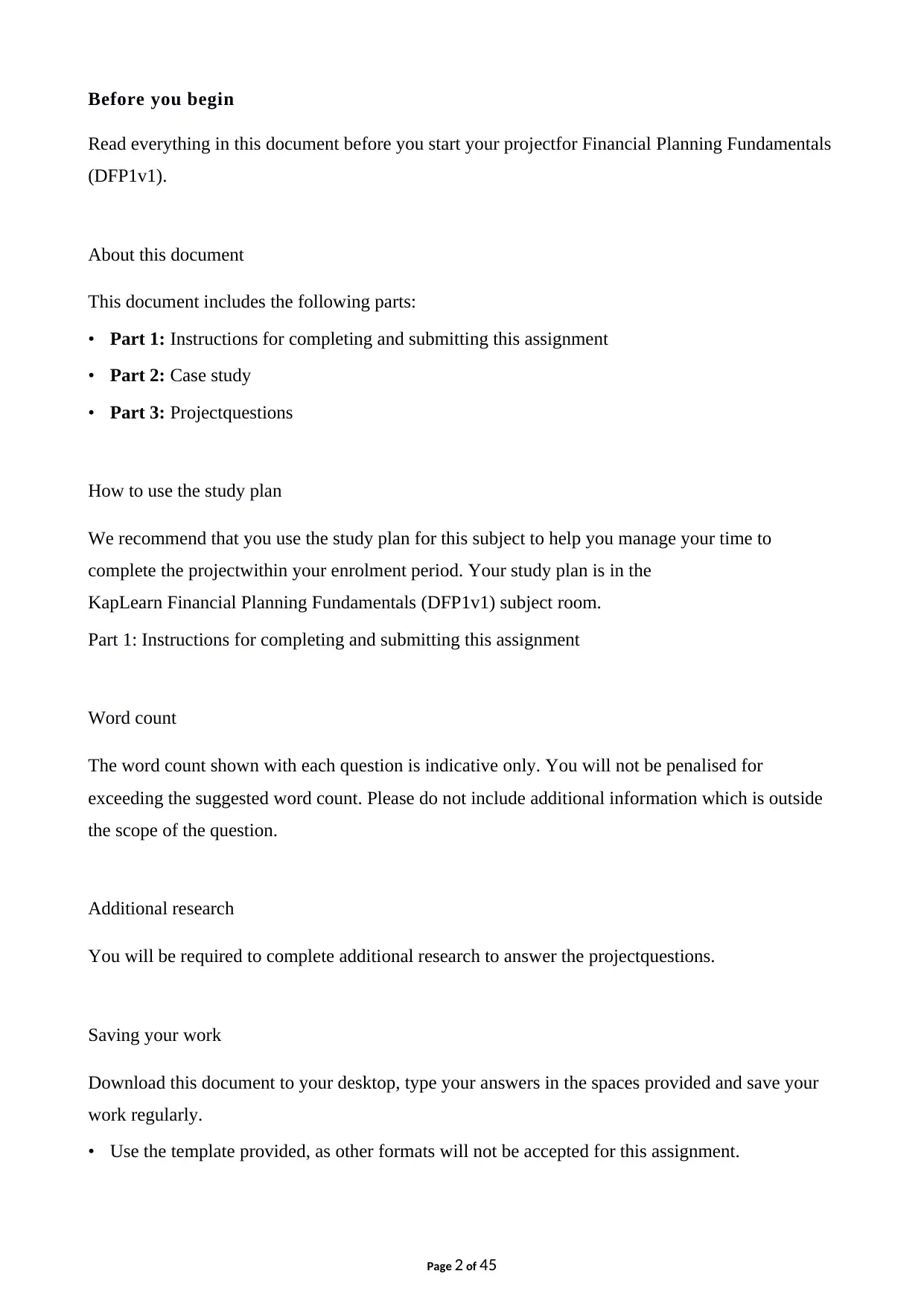
Before you begin
Read everything in this document before you start your projectfor Financial Planning Fundamentals
(DFP1v1).
About this document
This document includes the following parts:
• Part 1: Instructions for completing and submitting this assignment
• Part 2: Case study
• Part 3: Projectquestions
How to use the study plan
We recommend that you use the study plan for this subject to help you manage your time to
complete the projectwithin your enrolment period. Your study plan is in the
KapLearn Financial Planning Fundamentals (DFP1v1) subject room.
Part 1: Instructions for completing and submitting this assignment
Word count
The word count shown with each question is indicative only. You will not be penalised for
exceeding the suggested word count. Please do not include additional information which is outside
the scope of the question.
Additional research
You will be required to complete additional research to answer the projectquestions.
Saving your work
Download this document to your desktop, type your answers in the spaces provided and save your
work regularly.
• Use the template provided, as other formats will not be accepted for this assignment.
Page 2 of 45
Read everything in this document before you start your projectfor Financial Planning Fundamentals
(DFP1v1).
About this document
This document includes the following parts:
• Part 1: Instructions for completing and submitting this assignment
• Part 2: Case study
• Part 3: Projectquestions
How to use the study plan
We recommend that you use the study plan for this subject to help you manage your time to
complete the projectwithin your enrolment period. Your study plan is in the
KapLearn Financial Planning Fundamentals (DFP1v1) subject room.
Part 1: Instructions for completing and submitting this assignment
Word count
The word count shown with each question is indicative only. You will not be penalised for
exceeding the suggested word count. Please do not include additional information which is outside
the scope of the question.
Additional research
You will be required to complete additional research to answer the projectquestions.
Saving your work
Download this document to your desktop, type your answers in the spaces provided and save your
work regularly.
• Use the template provided, as other formats will not be accepted for this assignment.
Page 2 of 45

• Name your file as follows: Studentnumber_SubjectCode_Submissionnumber
(e.g. 12345678_DFP1_Submission1).
• Include your student ID on the first page of the assignment.
Before you submit your work, please do a spell check and proofread your work to ensure that
everything is clear and unambiguous.
Page 3 of 45
(e.g. 12345678_DFP1_Submission1).
• Include your student ID on the first page of the assignment.
Before you submit your work, please do a spell check and proofread your work to ensure that
everything is clear and unambiguous.
Page 3 of 45
⊘ This is a preview!⊘
Do you want full access?
Subscribe today to unlock all pages.

Trusted by 1+ million students worldwide
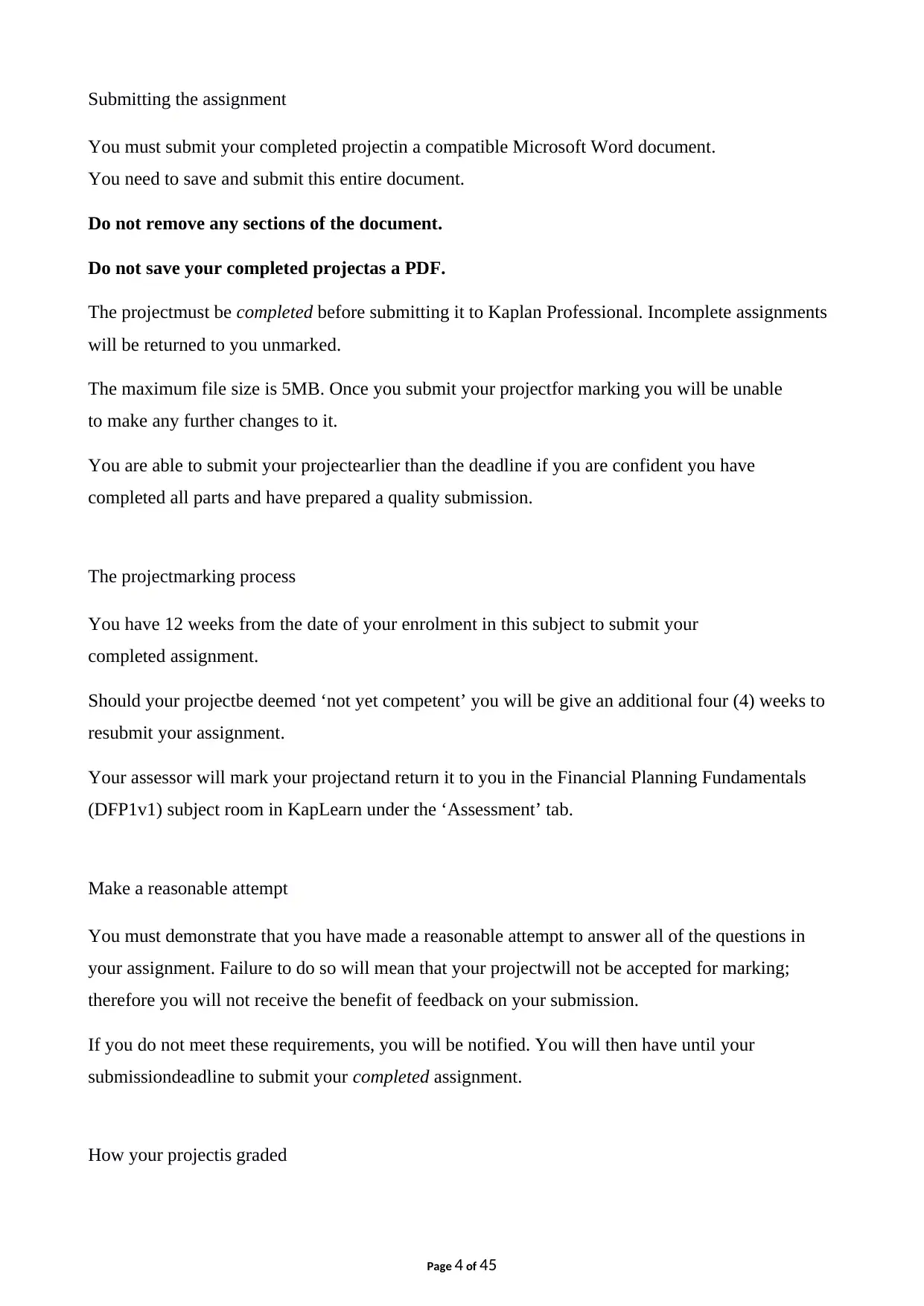
Submitting the assignment
You must submit your completed projectin a compatible Microsoft Word document.
You need to save and submit this entire document.
Do not remove any sections of the document.
Do not save your completed projectas a PDF.
The projectmust be completed before submitting it to Kaplan Professional. Incomplete assignments
will be returned to you unmarked.
The maximum file size is 5MB. Once you submit your projectfor marking you will be unable
to make any further changes to it.
You are able to submit your projectearlier than the deadline if you are confident you have
completed all parts and have prepared a quality submission.
The projectmarking process
You have 12 weeks from the date of your enrolment in this subject to submit your
completed assignment.
Should your projectbe deemed ‘not yet competent’ you will be give an additional four (4) weeks to
resubmit your assignment.
Your assessor will mark your projectand return it to you in the Financial Planning Fundamentals
(DFP1v1) subject room in KapLearn under the ‘Assessment’ tab.
Make a reasonable attempt
You must demonstrate that you have made a reasonable attempt to answer all of the questions in
your assignment. Failure to do so will mean that your projectwill not be accepted for marking;
therefore you will not receive the benefit of feedback on your submission.
If you do not meet these requirements, you will be notified. You will then have until your
submissiondeadline to submit your completed assignment.
How your projectis graded
Page 4 of 45
You must submit your completed projectin a compatible Microsoft Word document.
You need to save and submit this entire document.
Do not remove any sections of the document.
Do not save your completed projectas a PDF.
The projectmust be completed before submitting it to Kaplan Professional. Incomplete assignments
will be returned to you unmarked.
The maximum file size is 5MB. Once you submit your projectfor marking you will be unable
to make any further changes to it.
You are able to submit your projectearlier than the deadline if you are confident you have
completed all parts and have prepared a quality submission.
The projectmarking process
You have 12 weeks from the date of your enrolment in this subject to submit your
completed assignment.
Should your projectbe deemed ‘not yet competent’ you will be give an additional four (4) weeks to
resubmit your assignment.
Your assessor will mark your projectand return it to you in the Financial Planning Fundamentals
(DFP1v1) subject room in KapLearn under the ‘Assessment’ tab.
Make a reasonable attempt
You must demonstrate that you have made a reasonable attempt to answer all of the questions in
your assignment. Failure to do so will mean that your projectwill not be accepted for marking;
therefore you will not receive the benefit of feedback on your submission.
If you do not meet these requirements, you will be notified. You will then have until your
submissiondeadline to submit your completed assignment.
How your projectis graded
Page 4 of 45
Paraphrase This Document
Need a fresh take? Get an instant paraphrase of this document with our AI Paraphraser

Projecttasks are used to determine your ‘competence’ in demonstrating the required knowledge
and/or skills for each subject. As a result, you will be graded as either competent or not yet
competent.
Your assessor will follow the below process when marking your assignment:
• Assess your responses to each question, and sub-parts if applicable, and then determine whether
you have demonstrated competence in each question.
• Determine if, on a holistic basis, your responses to the questions have demonstrated overall
competence.
Page 5 of 45
and/or skills for each subject. As a result, you will be graded as either competent or not yet
competent.
Your assessor will follow the below process when marking your assignment:
• Assess your responses to each question, and sub-parts if applicable, and then determine whether
you have demonstrated competence in each question.
• Determine if, on a holistic basis, your responses to the questions have demonstrated overall
competence.
Page 5 of 45

‘Not yet competent’ and resubmissions
Should sections of your projectbe marked as ‘not yet competent’ you will be given an additional
opportunity to amend your responses so that you can demonstrate your competency to the
required level.
You must address the assessor’s feedback in your amended responses. You only need amend those
sections where the assessor has determined you are ‘not yet competent’.
Make changes to your original submission. Use a different text colour for your resubmission.
Your assessor will be in a better position to gauge the quality and nature of your changes.
Ensure you leave your first assessor’s comments in your assignment, so your second assessor can
see the instructions that were originally provided for you. Do not change any comments made by
a Kaplan assessor.
Units of competency
This projectis your opportunity to demonstrate your competency against these units:
FNSFPL502 Conduct financial planning analysis and research
FNSFPL501 Comply with financial planning practice ethical and operational
guidelines and regulations
FNSFPL506 Determine client financial requirements and expectations
FNSINC401 Apply principles of professional practice to work in the financial
services industry
BSBITU402 Develop and use complex spreadsheets
FNSASIC301 Establish client relationship and analyse needs
FNSASIC302 Develop, present and negotiate client solutions
FNSIAD301 Provide general advice on financial products and services
We are here to help
If you have any questions about this projectyou can post your query at the ‘Ask your Tutor’ forum
in your subject room. You can expect an answer within 24 hours of your posting from one of our
technical advisers or student support staff.
Page 6 of 45
Should sections of your projectbe marked as ‘not yet competent’ you will be given an additional
opportunity to amend your responses so that you can demonstrate your competency to the
required level.
You must address the assessor’s feedback in your amended responses. You only need amend those
sections where the assessor has determined you are ‘not yet competent’.
Make changes to your original submission. Use a different text colour for your resubmission.
Your assessor will be in a better position to gauge the quality and nature of your changes.
Ensure you leave your first assessor’s comments in your assignment, so your second assessor can
see the instructions that were originally provided for you. Do not change any comments made by
a Kaplan assessor.
Units of competency
This projectis your opportunity to demonstrate your competency against these units:
FNSFPL502 Conduct financial planning analysis and research
FNSFPL501 Comply with financial planning practice ethical and operational
guidelines and regulations
FNSFPL506 Determine client financial requirements and expectations
FNSINC401 Apply principles of professional practice to work in the financial
services industry
BSBITU402 Develop and use complex spreadsheets
FNSASIC301 Establish client relationship and analyse needs
FNSASIC302 Develop, present and negotiate client solutions
FNSIAD301 Provide general advice on financial products and services
We are here to help
If you have any questions about this projectyou can post your query at the ‘Ask your Tutor’ forum
in your subject room. You can expect an answer within 24 hours of your posting from one of our
technical advisers or student support staff.
Page 6 of 45
⊘ This is a preview!⊘
Do you want full access?
Subscribe today to unlock all pages.

Trusted by 1+ million students worldwide
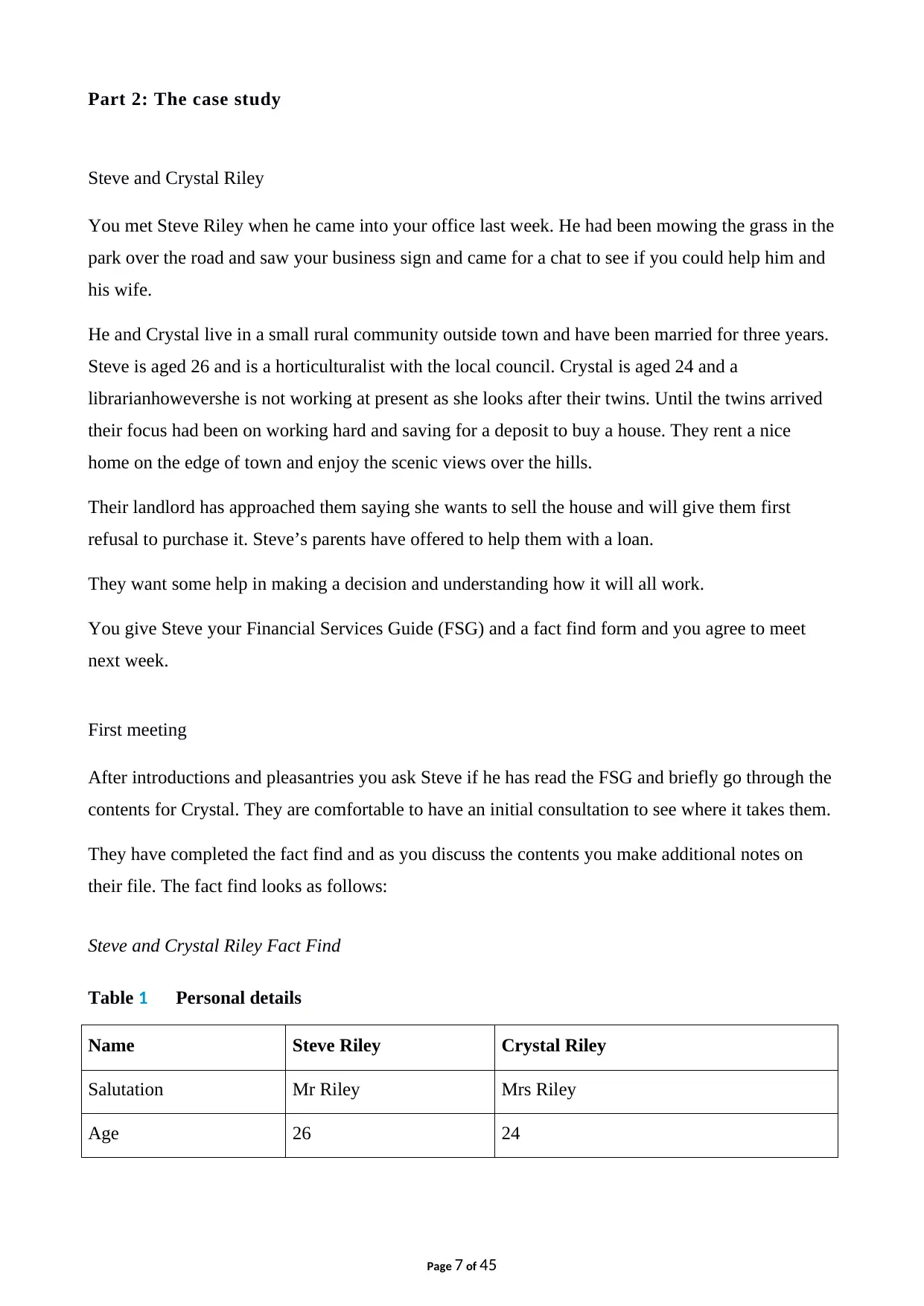
Part 2: The case study
Steve and Crystal Riley
You met Steve Riley when he came into your office last week. He had been mowing the grass in the
park over the road and saw your business sign and came for a chat to see if you could help him and
his wife.
He and Crystal live in a small rural community outside town and have been married for three years.
Steve is aged 26 and is a horticulturalist with the local council. Crystal is aged 24 and a
librarianhowevershe is not working at present as she looks after their twins. Until the twins arrived
their focus had been on working hard and saving for a deposit to buy a house. They rent a nice
home on the edge of town and enjoy the scenic views over the hills.
Their landlord has approached them saying she wants to sell the house and will give them first
refusal to purchase it. Steve’s parents have offered to help them with a loan.
They want some help in making a decision and understanding how it will all work.
You give Steve your Financial Services Guide (FSG) and a fact find form and you agree to meet
next week.
First meeting
After introductions and pleasantries you ask Steve if he has read the FSG and briefly go through the
contents for Crystal. They are comfortable to have an initial consultation to see where it takes them.
They have completed the fact find and as you discuss the contents you make additional notes on
their file. The fact find looks as follows:
Steve and Crystal Riley Fact Find
Table 1 Personal details
Name Steve Riley Crystal Riley
Salutation Mr Riley Mrs Riley
Age 26 24
Page 7 of 45
Steve and Crystal Riley
You met Steve Riley when he came into your office last week. He had been mowing the grass in the
park over the road and saw your business sign and came for a chat to see if you could help him and
his wife.
He and Crystal live in a small rural community outside town and have been married for three years.
Steve is aged 26 and is a horticulturalist with the local council. Crystal is aged 24 and a
librarianhowevershe is not working at present as she looks after their twins. Until the twins arrived
their focus had been on working hard and saving for a deposit to buy a house. They rent a nice
home on the edge of town and enjoy the scenic views over the hills.
Their landlord has approached them saying she wants to sell the house and will give them first
refusal to purchase it. Steve’s parents have offered to help them with a loan.
They want some help in making a decision and understanding how it will all work.
You give Steve your Financial Services Guide (FSG) and a fact find form and you agree to meet
next week.
First meeting
After introductions and pleasantries you ask Steve if he has read the FSG and briefly go through the
contents for Crystal. They are comfortable to have an initial consultation to see where it takes them.
They have completed the fact find and as you discuss the contents you make additional notes on
their file. The fact find looks as follows:
Steve and Crystal Riley Fact Find
Table 1 Personal details
Name Steve Riley Crystal Riley
Salutation Mr Riley Mrs Riley
Age 26 24
Page 7 of 45
Paraphrase This Document
Need a fresh take? Get an instant paraphrase of this document with our AI Paraphraser
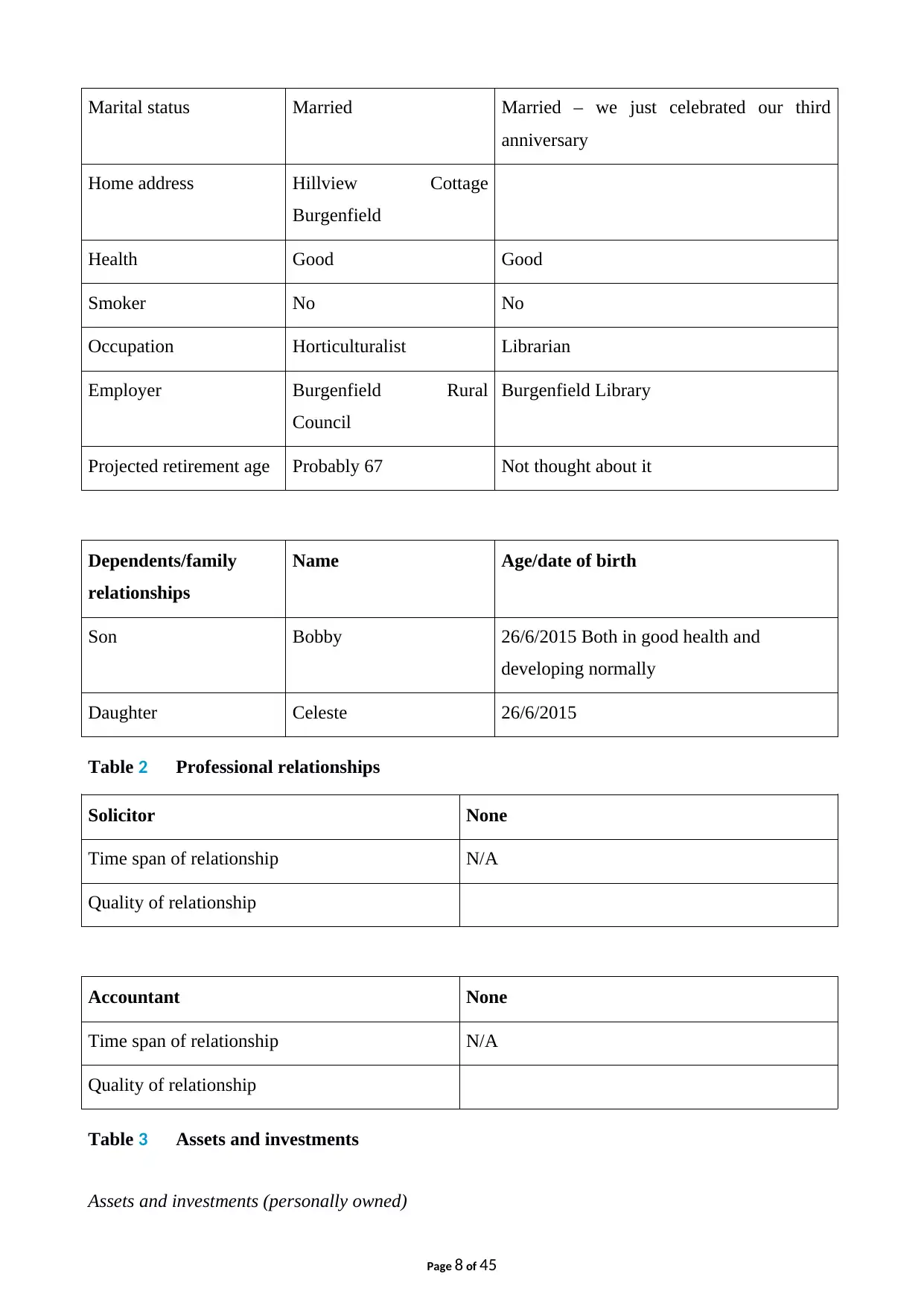
Marital status Married Married – we just celebrated our third
anniversary
Home address Hillview Cottage
Burgenfield
Health Good Good
Smoker No No
Occupation Horticulturalist Librarian
Employer Burgenfield Rural
Council
Burgenfield Library
Projected retirement age Probably 67 Not thought about it
Dependents/family
relationships
Name Age/date of birth
Son Bobby 26/6/2015 Both in good health and
developing normally
Daughter Celeste 26/6/2015
Table 2 Professional relationships
Solicitor None
Time span of relationship N/A
Quality of relationship
Accountant None
Time span of relationship N/A
Quality of relationship
Table 3 Assets and investments
Assets and investments (personally owned)
Page 8 of 45
anniversary
Home address Hillview Cottage
Burgenfield
Health Good Good
Smoker No No
Occupation Horticulturalist Librarian
Employer Burgenfield Rural
Council
Burgenfield Library
Projected retirement age Probably 67 Not thought about it
Dependents/family
relationships
Name Age/date of birth
Son Bobby 26/6/2015 Both in good health and
developing normally
Daughter Celeste 26/6/2015
Table 2 Professional relationships
Solicitor None
Time span of relationship N/A
Quality of relationship
Accountant None
Time span of relationship N/A
Quality of relationship
Table 3 Assets and investments
Assets and investments (personally owned)
Page 8 of 45

Assets Value Owners
hip
status
Other information Purchase
price
Everyday bank
account
$500 Joint We try to keep at least this amount in the
account. We’d like to have more cash on
hand for the unexpected because with the
twins something is always happening
Steve’s ute $4000 Steve It’s 12 years old and still running well.
It’s a great little workhorse
$15,000
Crystal’s sedan $12,000 Crystal It’s only three years old and I love it.
The four doors and hatchback make it
great to take the kids out and for shopping
$18,000
Home contents $7000 Joint Includes gardening equipment that Steve
uses for part-time gardening jobs
Bonus saving
account
$22,500 Joint We were saving quite well and enjoying a
carefree lifestyle until the twins came
along but for the last year we have often
had to resist the temptation to dip into it.
We get extra interest if we don’t make
withdrawals
Table 4 Liabilities
Debts Value Payme
nt
Ownership
status
Other information Interest
rate
Credit
card
$2500 Minimu
m
Joint We would prefer to pay it off each
month but we spent a lot rearranging
the house for the twins when they
arrived
22.5%
Car loan $5400 $61pw Crystal There are two years until it’s paid out 13.5%
HECS
debt
$12,00
0
None Crystal From Crystal’s librarian course CPI
Page 9 of 45
hip
status
Other information Purchase
price
Everyday bank
account
$500 Joint We try to keep at least this amount in the
account. We’d like to have more cash on
hand for the unexpected because with the
twins something is always happening
Steve’s ute $4000 Steve It’s 12 years old and still running well.
It’s a great little workhorse
$15,000
Crystal’s sedan $12,000 Crystal It’s only three years old and I love it.
The four doors and hatchback make it
great to take the kids out and for shopping
$18,000
Home contents $7000 Joint Includes gardening equipment that Steve
uses for part-time gardening jobs
Bonus saving
account
$22,500 Joint We were saving quite well and enjoying a
carefree lifestyle until the twins came
along but for the last year we have often
had to resist the temptation to dip into it.
We get extra interest if we don’t make
withdrawals
Table 4 Liabilities
Debts Value Payme
nt
Ownership
status
Other information Interest
rate
Credit
card
$2500 Minimu
m
Joint We would prefer to pay it off each
month but we spent a lot rearranging
the house for the twins when they
arrived
22.5%
Car loan $5400 $61pw Crystal There are two years until it’s paid out 13.5%
HECS
debt
$12,00
0
None Crystal From Crystal’s librarian course CPI
Page 9 of 45
⊘ This is a preview!⊘
Do you want full access?
Subscribe today to unlock all pages.

Trusted by 1+ million students worldwide

Table 5 Superannuation
Fund Value Ownershi
p
Other information
SunSuper $16,300 Steve From my job with the Council. I’ve been with them since I
left school and did my apprenticeship
Council
Super
$11,800 Crystal From my job in the library since I finished Uni
Table 6 Income p.a.
Income type per
annum
Steve Crystal Notes
Salary $48,000 Super on top of this. I hope to get the supervisor’s
job in a couple of years when the current guy
retires
Salary $5000 I was on $47,000 before I took time off to have the
kids. I’m not sure how long I’ll be away but I
don’t want to lose the opportunity to work locally.
This is my town and I love it
I still do some work from home for the library. I
hope I’ll earn $5000 a year but we’ll see
Centrelink About
$17,500
About $675 a fortnight
Interest $394 $394 From the home deposit saving fund
Total combined
gross income
$71,288
Table 7 Estimated annualexpenditures
Expense per year Joint Notes
Accountant’s fees A friend does our tax online
Charitable donations None
Page 10 of 45
Fund Value Ownershi
p
Other information
SunSuper $16,300 Steve From my job with the Council. I’ve been with them since I
left school and did my apprenticeship
Council
Super
$11,800 Crystal From my job in the library since I finished Uni
Table 6 Income p.a.
Income type per
annum
Steve Crystal Notes
Salary $48,000 Super on top of this. I hope to get the supervisor’s
job in a couple of years when the current guy
retires
Salary $5000 I was on $47,000 before I took time off to have the
kids. I’m not sure how long I’ll be away but I
don’t want to lose the opportunity to work locally.
This is my town and I love it
I still do some work from home for the library. I
hope I’ll earn $5000 a year but we’ll see
Centrelink About
$17,500
About $675 a fortnight
Interest $394 $394 From the home deposit saving fund
Total combined
gross income
$71,288
Table 7 Estimated annualexpenditures
Expense per year Joint Notes
Accountant’s fees A friend does our tax online
Charitable donations None
Page 10 of 45
Paraphrase This Document
Need a fresh take? Get an instant paraphrase of this document with our AI Paraphraser
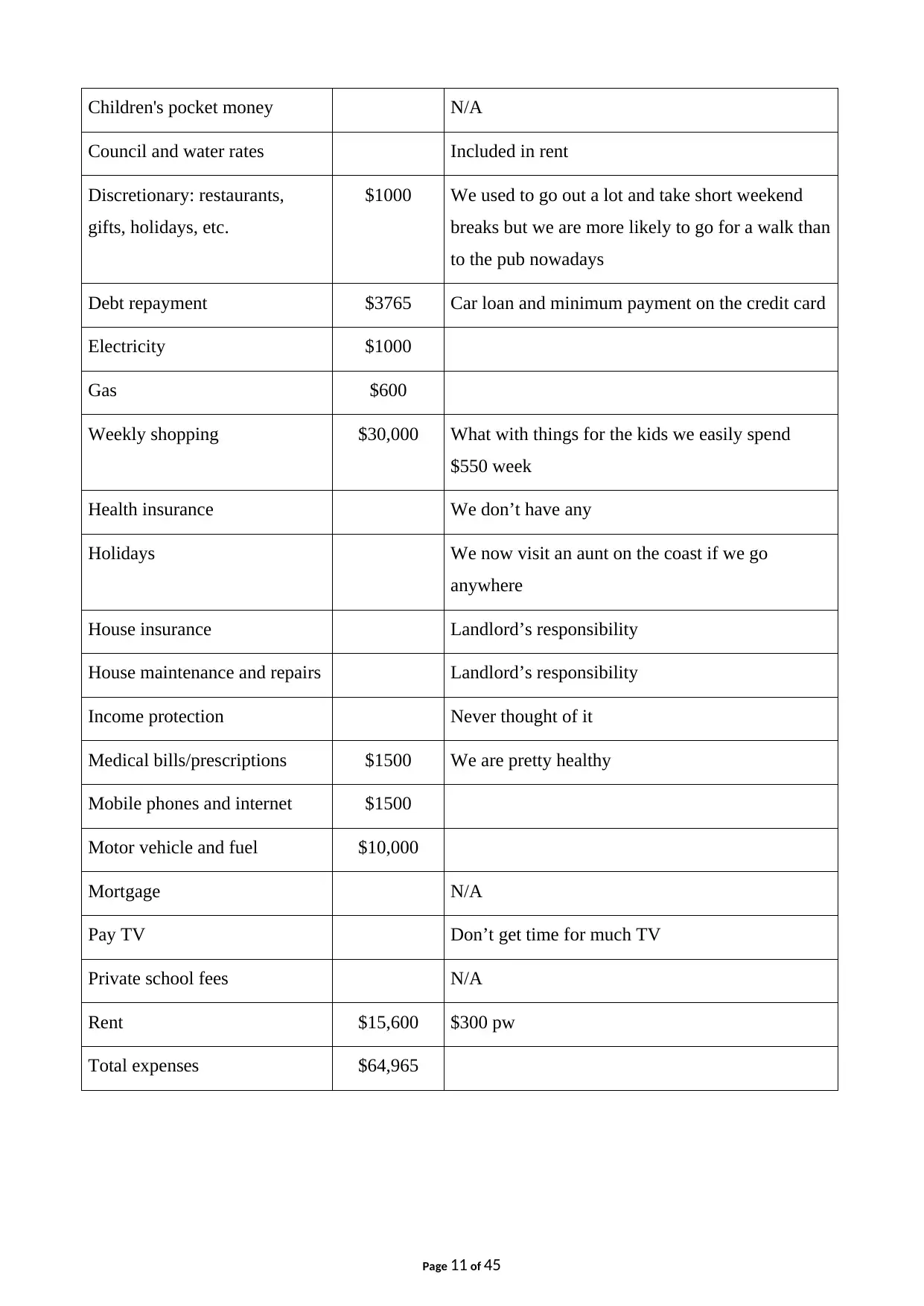
Children's pocket money N/A
Council and water rates Included in rent
Discretionary: restaurants,
gifts, holidays, etc.
$1000 We used to go out a lot and take short weekend
breaks but we are more likely to go for a walk than
to the pub nowadays
Debt repayment $3765 Car loan and minimum payment on the credit card
Electricity $1000
Gas $600
Weekly shopping $30,000 What with things for the kids we easily spend
$550 week
Health insurance We don’t have any
Holidays We now visit an aunt on the coast if we go
anywhere
House insurance Landlord’s responsibility
House maintenance and repairs Landlord’s responsibility
Income protection Never thought of it
Medical bills/prescriptions $1500 We are pretty healthy
Mobile phones and internet $1500
Motor vehicle and fuel $10,000
Mortgage N/A
Pay TV Don’t get time for much TV
Private school fees N/A
Rent $15,600 $300 pw
Total expenses $64,965
Page 11 of 45
Council and water rates Included in rent
Discretionary: restaurants,
gifts, holidays, etc.
$1000 We used to go out a lot and take short weekend
breaks but we are more likely to go for a walk than
to the pub nowadays
Debt repayment $3765 Car loan and minimum payment on the credit card
Electricity $1000
Gas $600
Weekly shopping $30,000 What with things for the kids we easily spend
$550 week
Health insurance We don’t have any
Holidays We now visit an aunt on the coast if we go
anywhere
House insurance Landlord’s responsibility
House maintenance and repairs Landlord’s responsibility
Income protection Never thought of it
Medical bills/prescriptions $1500 We are pretty healthy
Mobile phones and internet $1500
Motor vehicle and fuel $10,000
Mortgage N/A
Pay TV Don’t get time for much TV
Private school fees N/A
Rent $15,600 $300 pw
Total expenses $64,965
Page 11 of 45
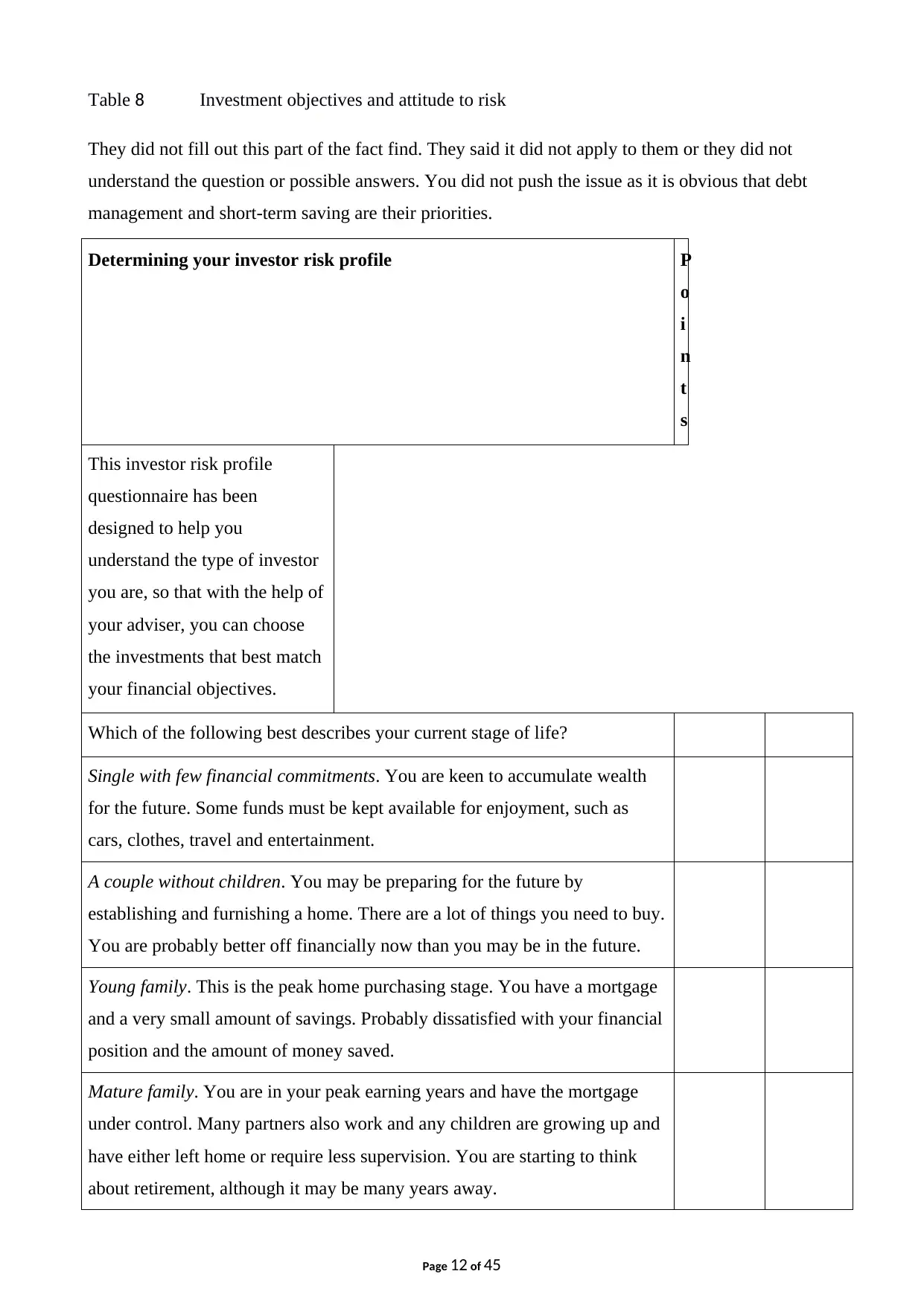
Table 8 Investment objectives and attitude to risk
They did not fill out this part of the fact find. They said it did not apply to them or they did not
understand the question or possible answers. You did not push the issue as it is obvious that debt
management and short-term saving are their priorities.
Determining your investor risk profile P
o
i
n
t
s
This investor risk profile
questionnaire has been
designed to help you
understand the type of investor
you are, so that with the help of
your adviser, you can choose
the investments that best match
your financial objectives.
Which of the following best describes your current stage of life?
Single with few financial commitments. You are keen to accumulate wealth
for the future. Some funds must be kept available for enjoyment, such as
cars, clothes, travel and entertainment.
A couple without children. You may be preparing for the future by
establishing and furnishing a home. There are a lot of things you need to buy.
You are probably better off financially now than you may be in the future.
Young family. This is the peak home purchasing stage. You have a mortgage
and a very small amount of savings. Probably dissatisfied with your financial
position and the amount of money saved.
Mature family. You are in your peak earning years and have the mortgage
under control. Many partners also work and any children are growing up and
have either left home or require less supervision. You are starting to think
about retirement, although it may be many years away.
Page 12 of 45
They did not fill out this part of the fact find. They said it did not apply to them or they did not
understand the question or possible answers. You did not push the issue as it is obvious that debt
management and short-term saving are their priorities.
Determining your investor risk profile P
o
i
n
t
s
This investor risk profile
questionnaire has been
designed to help you
understand the type of investor
you are, so that with the help of
your adviser, you can choose
the investments that best match
your financial objectives.
Which of the following best describes your current stage of life?
Single with few financial commitments. You are keen to accumulate wealth
for the future. Some funds must be kept available for enjoyment, such as
cars, clothes, travel and entertainment.
A couple without children. You may be preparing for the future by
establishing and furnishing a home. There are a lot of things you need to buy.
You are probably better off financially now than you may be in the future.
Young family. This is the peak home purchasing stage. You have a mortgage
and a very small amount of savings. Probably dissatisfied with your financial
position and the amount of money saved.
Mature family. You are in your peak earning years and have the mortgage
under control. Many partners also work and any children are growing up and
have either left home or require less supervision. You are starting to think
about retirement, although it may be many years away.
Page 12 of 45
⊘ This is a preview!⊘
Do you want full access?
Subscribe today to unlock all pages.

Trusted by 1+ million students worldwide
1 out of 42
Related Documents
Your All-in-One AI-Powered Toolkit for Academic Success.
+13062052269
info@desklib.com
Available 24*7 on WhatsApp / Email
![[object Object]](/_next/static/media/star-bottom.7253800d.svg)
Unlock your academic potential
Copyright © 2020–2025 A2Z Services. All Rights Reserved. Developed and managed by ZUCOL.





